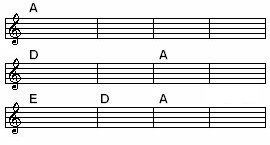Scroll through the lesson and click on notation/video/audio links to load the interactive players.
Please subscribe to get full access to all lessons for only $7.95/month PLUS 1 week free trial.

Riff Interactive lessons are
LESS expensive and
MORE interactive than alternatives!
More Info
|
|

Jam Sessions - Rock
Style II
Lesson 9 - Jam in A
Lyle: As
I was reviewed some of the other Jam Sessions in this Rock style, I notice I
didn't have a real "old school" style rock jam. So I made a jam track in the
style of Mr. Rock 'n Roll himself, Chuck Berry. It makes you want to get up and
move. Makes your fingers want to wiggle about too. Here's the jam track for this
lesson in the key of A:
Lyle:
It's based off a simple 12 bar chord progression:
chord
chart

Lyle: The classic rhythm guitar riff goes like
this:
Lyle:
This jam may sound a little like the blues but it's early rock style. It has a
straight 8th note rhythm instead of a swing or shuffle beat. It's driving hard
and pounding out the rhythm just like they did in the early days of rock 'n
roll. Early rock music came from a mixture of the blues, country, and even jazz.
Lyle:
The basic scales to use while jamming to this groove in A would be the A major
and minor pentatonic scales. I like to use the major pentatonic scale over the A
(I) and E (V) chords, the minor pentatonic over the D (IV) chord.
Lyle:
Look and listen to the next Tab file. Notice the A minor pentatonic scale is
only used during the D chord within the progression:
Lyle: This is not a hard rule or something that
always has to be, it's just one thing I'm trying to teach you. There are not too
many rules when jamming the blues and rock. If it sounds good, just do it!
Lyle:
The A maj pent has a C# in it, the A minor pent has a C natural in it. Look at
the two chords in the next TAB. The circled note for the first chord on the G
string is the major 3rd degree in the key of A. The A major chord has a C# as
its 3rd degree, the D chord has a C natural as its b7th degree like a D7 or D9
chord. So when jamming or improvising, the major pentatonic makes good sense
during the I and V chords, the minor pentatonic over the IV chord.
Lyle:
The second chord - D7, has a circled note on the third string but this time it's
a flatted 3rd degree in the key of A.
Lyle: Any questions?
write: The D7 would usually be the five seven chord in
the key of G. Is that correct.
Lyle: Right, but in Blues and Rock you can turn
the IV chord into a dominant 7 sometimes. For extra flavor.
Lyle: Let's look at the first solo from the
lesson sample. You'll see that it's made from the major pentatonic, then
switches to the minor pentatonic during the D chord.
Lyle:
You can play the A minor pentatonic during the whole progression if you
wanted.
Lyle:
Let's look at the second solo which is played 12 frets higher than the first
solo. It uses the same ideas for the use of pentatonics. First check out and
listen to the scales flow over the jam:
Lyle:
Watch for the changes during the D chord, the solo shifts to the A minor
pentatonic during the D chord.
Lyle:
Everyone jammin'?
phil: yep cool
Pacer: working up a sweat
Danny:
yes
write: Wish
I had found these lessons sooner in my career.
Lyle: :-)
Lyle: Remember you can start a rock n roll jam
using the major pent, then switch to the minor pent during the 4
chord.
Lyle: See you at the next jam!
|
<< load notation from left
|
|
<< load audio from left
|
<< load audio from left
|